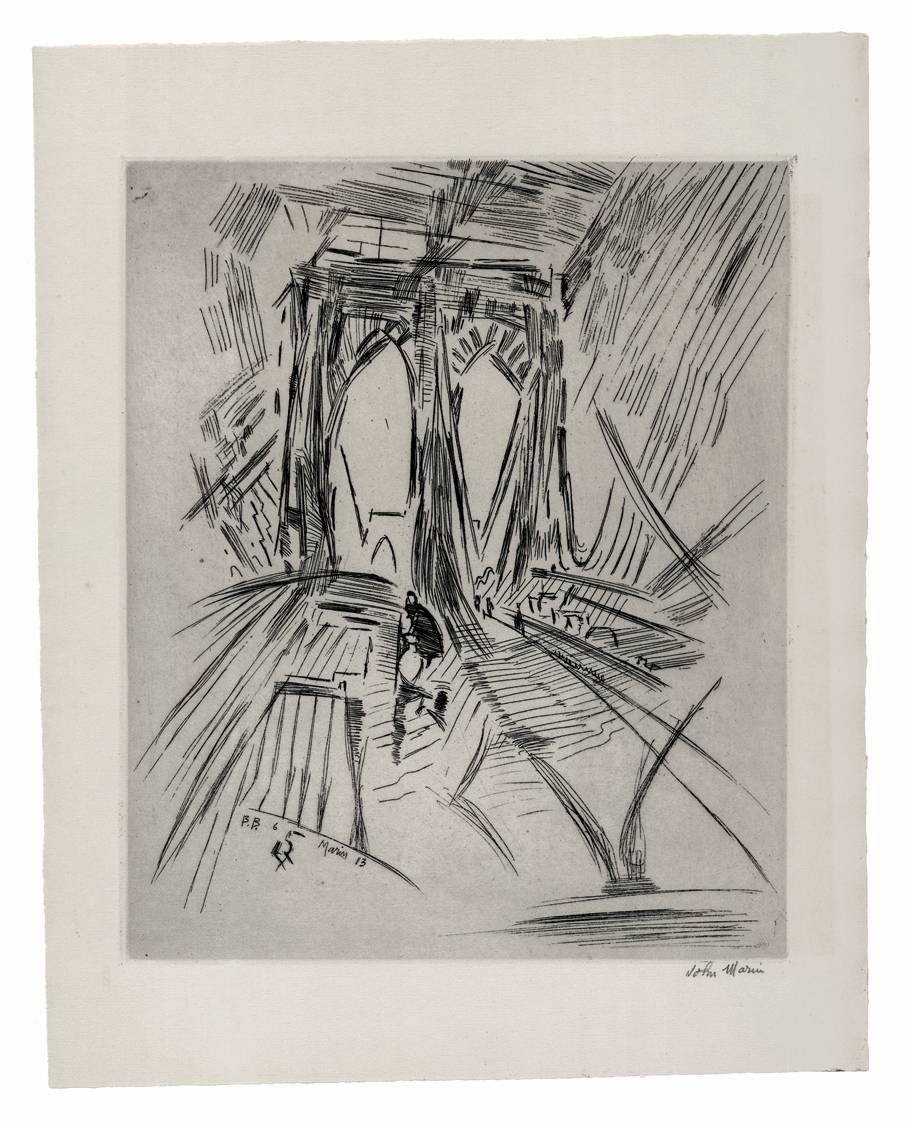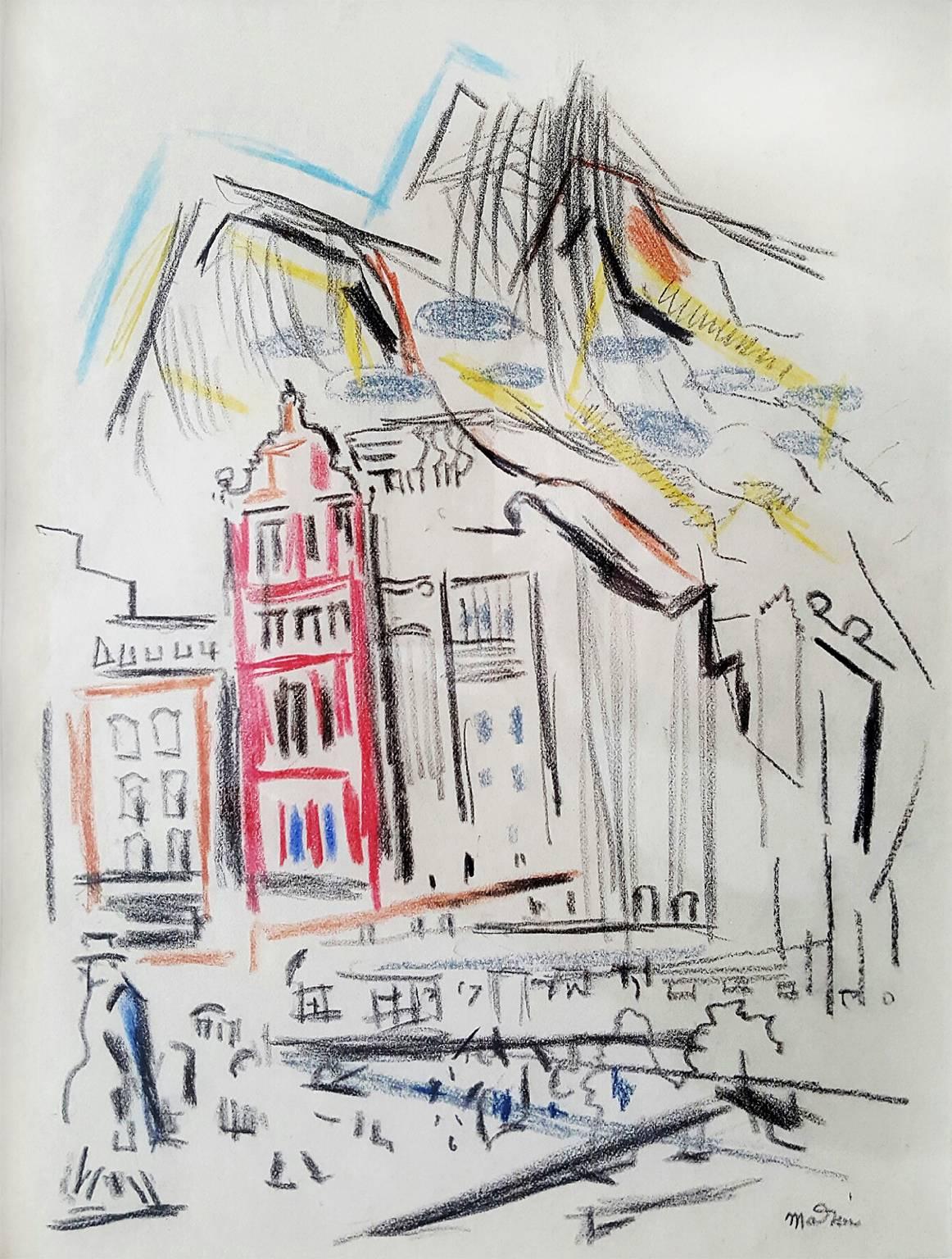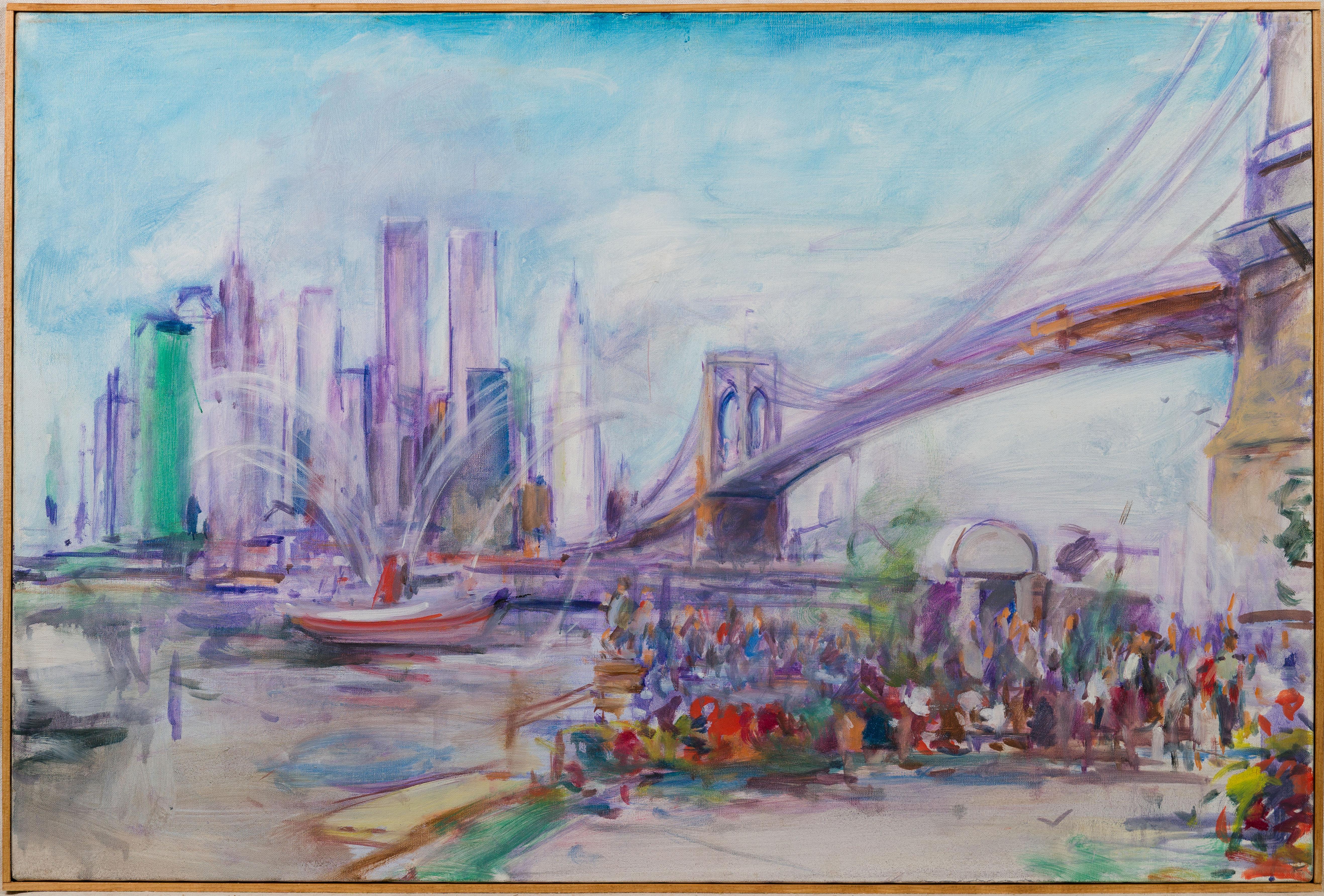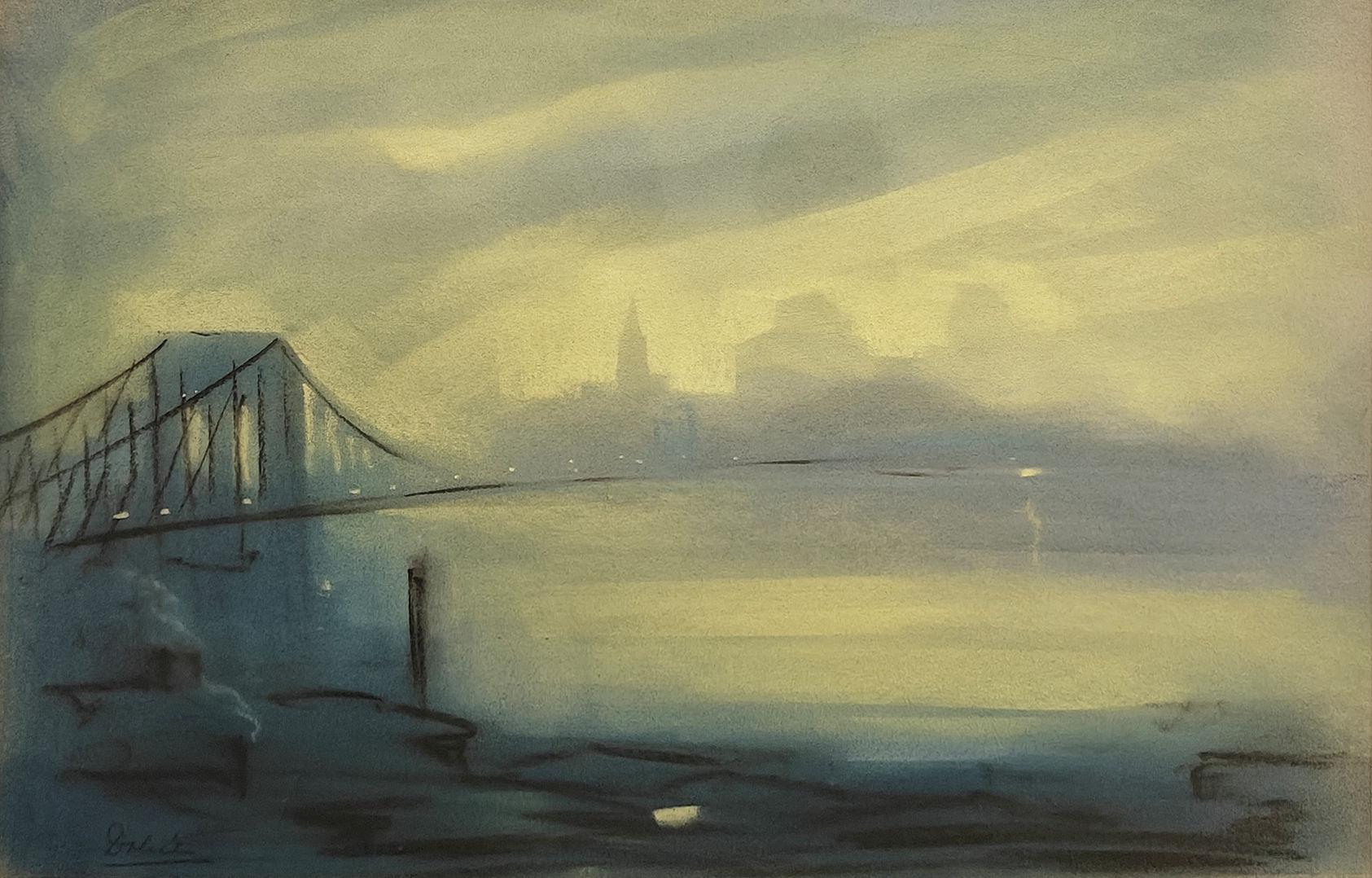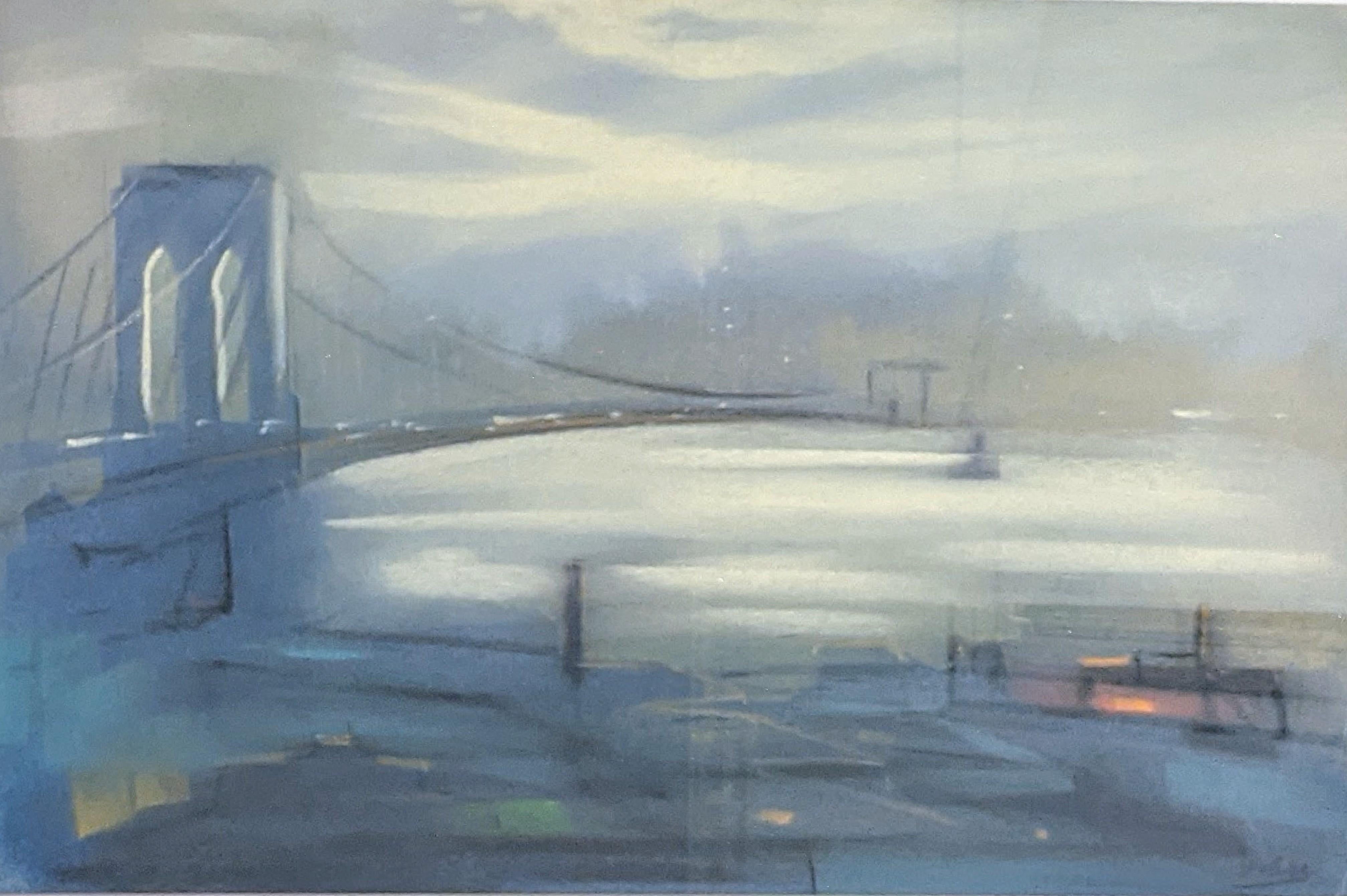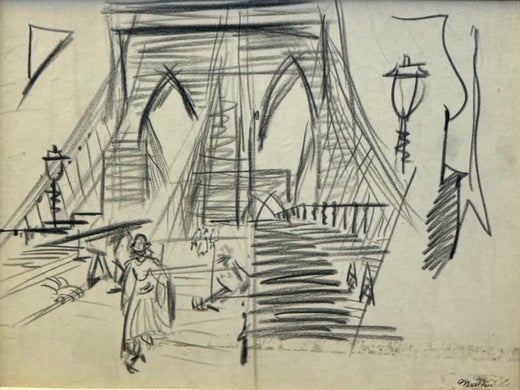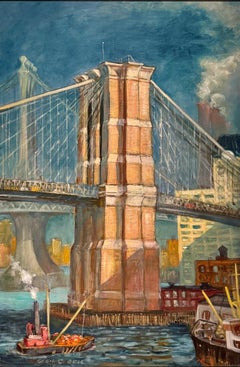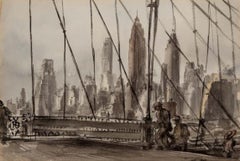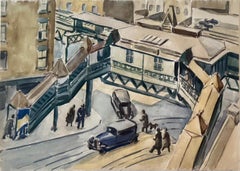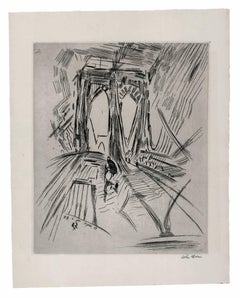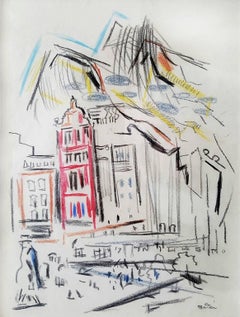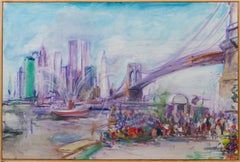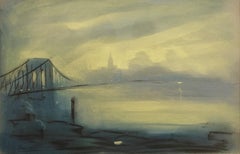Items Similar to Brooklyn Bridge NYC American Scene Ashcan 20th Century Social Realism Modern
Want more images or videos?
Request additional images or videos from the seller
1 of 9
John MarinBrooklyn Bridge NYC American Scene Ashcan 20th Century Social Realism Modernc. 1925
c. 1925
$39,000
£29,608.13
€33,865.39
CA$54,488.66
A$60,603.28
CHF 31,645.15
MX$737,477.44
NOK 404,156.84
SEK 379,027.82
DKK 252,750.38
Shipping
Retrieving quote...The 1stDibs Promise:
Authenticity Guarantee,
Money-Back Guarantee,
24-Hour Cancellation
About the Item
Brooklyn Bridge NYC American Scene Ashcan 20th Century Social Realism Modern
John Marin (1870-1953)
Brooklyn Bridge
7 1/2 x 9 7/8 inches
Graphite on paper
Signed lower right, c. 1925
Framed 12 1/2 x 15 inches
Labels verso Kennedy Galleries,
Los Angeles County Museum
Bio
ohn Marin was born in Rutherford, New Jersey in 1870. His father was a public accountant; his mother died only nine days after his birth. He was taken to his maternal grandparents with whom he lived in Weehawken, New Jersey. His grandparents, with their son and two daughters were the only parents Marin was to know; it has been suggested that his father seems to have ignored him. As a child of seven or eight Marin began to sketch and when he was a teenager he had completed his earliest watercolors. His education in the schools of New Jersey was interspersed with summers of hunting, fishing and sketching; he traveled in the Catskills, and as far away as Wisconsin and Minnesota. But formal training was almost incidental to his development as an artist.
He is to America what Paul Cezanne was to France - an innovator who helped to oppose the influence of the narrative painters, the illustrators who were more interested in subject than form, in surface than substance. Marin brought to his work a combination of values which, at the turn of the century, was unique in this country: an aliveness of touch, colors that have both sparkle and solidity, and forms that are vibrant with an energy characteristic of our age.
Marin established himself as a practicing architect. In the early 1890s, he worked for four architects and by 1893 had designed six houses in Union Hill, New Jersey. At the age of twenty-eight, he decided to become a professional artist and studied briefly at the Pennsylvania Academy of Fine Arts in Philadelphia and the Art Students League in New York City.
As a watercolorist he had no equal. He used this fluid, spontaneous medium to abstract from objects - skyscrapers, boats, mountains and seas - a simplified anatomy of color and form and to define the pulsation of stresses and movements in the relationship of objects. It was a great disappointment, all his life, that his oil paintings did not achieve the popularity that his watercolors did.
From 1905 to 1910 he worked in Europe, where he was influenced by Whistler's watercolors. It was Alfred Stieglitz, Marin's lifetime friend and dealer, whose firm faith in his genius made his position in the art world possible. He developed a distinctive style that he used most characteristically in powerful watercolors of the Maine coast. During the 1920s he provided the dominant force in the movement away from naturalistic representation towards an art of expressive semi-abstraction.
He married Marie Jane Hughes after he returned to New York. They had one son, who grew up to run his father's considerable affairs. Marin continued to work at the same steady fast pace as long as he lived. Since 1908 he had produced 1700 paintings, an average of forty a year. He had made the frames for them as well. At the age of seventy-nine, he began to taper off from the days when he painted one hundred watercolors in a summer. He died in 1953.
- Creator:John Marin (1870-1953, American)
- Creation Year:c. 1925
- Dimensions:Height: 13 in (33.02 cm)Width: 15 in (38.1 cm)
- Medium:
- Movement & Style:
- Period:
- Condition:
- Gallery Location:New York, NY
- Reference Number:1stDibs: LU1156215034382
John Marin
John Marin was born in Rutherford, New Jersey in 1870. His father was a public accountant; his mother died nine days after his birth. He was taken to his maternal grandparents with whom he lived in Weehawken, New Jersey. His grandparents, with their son and two daughters were the only parents Marin was to know; it has been suggested that his father seems to have ignored him. As a child of seven or eight Marin began to sketch and when he was a teenager he had completed his earliest watercolors. His education in the schools of New Jersey was interspersed with summers of hunting, fishing and sketching; he traveled in the Catskills, and as far away as Wisconsin and Minnesota. But formal training was almost incidental to his development as an artist. He is to America what Paul Cezanne was to France - an innovator who helped to oppose the influence of the narrative painters, the illustrators who were more interested in subject than form, in surface than substance. Marin brought to his work a combination of values which, at the turn of the century, was unique in this country: an aliveness of touch, colors that have both sparkle and solidity, and forms that are vibrant with an energy characteristic of our age. Marin established himself as a practicing architect. In the early 1890s, he worked for four architects and by 1893 had designed six houses in Union Hill, New Jersey. At the age of twenty-eight, he decided to become a professional artist and studied briefly at the Pennsylvania Academy of Fine Arts in Philadelphia and the Art Students League in New York City. As a watercolorist he had no equal. He used this fluid, spontaneous medium to abstract from objects - skyscrapers, boats, mountains and seas - a simplified anatomy of color and form and to define the pulsation of stresses and movements in the relationship of objects. It was a great disappointment, all his life, that his oil paintings did not achieve the popularity that his watercolors did. From 1905 to 1910 he worked in Europe, where he was influenced by Whistler's watercolors. It was Alfred Stieglitz, Marin's lifetime friend and dealer, whose firm faith in his genius made his position in the art world possible. He developed a distinctive style that he used most characteristically in powerful watercolors of the Maine coast. During the 1920s he provided the dominant force in the movement away from naturalistic representation towards an art of expressive semi-abstraction. He married Marie Jane Hughes after he returned to New York. They had one son, who grew up to run his father's considerable affairs. Marin continued to work at the same steady fast pace as long as he lived. Since 1908 he had produced 1700 paintings, an average of forty a year. He had made the frames for them as well. At the age of seventy-nine, he began to taper off from the days when he painted one hundred watercolors in a summer. He died in 1953.
About the Seller
5.0
Gold Seller
Premium sellers maintaining a 4.3+ rating and 24-hour response times
Established in 2008
1stDibs seller since 2019
193 sales on 1stDibs
Typical response time: <1 hour
- ShippingRetrieving quote...Shipping from: Pawling, NY
- Return Policy
Authenticity Guarantee
In the unlikely event there’s an issue with an item’s authenticity, contact us within 1 year for a full refund. DetailsMoney-Back Guarantee
If your item is not as described, is damaged in transit, or does not arrive, contact us within 7 days for a full refund. Details24-Hour Cancellation
You have a 24-hour grace period in which to reconsider your purchase, with no questions asked.Vetted Professional Sellers
Our world-class sellers must adhere to strict standards for service and quality, maintaining the integrity of our listings.Price-Match Guarantee
If you find that a seller listed the same item for a lower price elsewhere, we’ll match it.Trusted Global Delivery
Our best-in-class carrier network provides specialized shipping options worldwide, including custom delivery.More From This Seller
View AllBrooklyn Bridge NYC American Scene Social Realism Mid 20th Century Modern WPA
By Cecil Crosley Bell
Located in New York, NY
Brooklyn Bridge NYC American Scene Social Realism Mid 20th Century Modern WPA
Cecil C. Bell (American, 1906-1970)
Brookyn Bridge amid the NYC Waterfront
35 ½ x 23 ½ inches
Oil on Bo...
Category
1930s American Realist Landscape Paintings
Materials
Oil, Board
Reginald Marsh "Brooklyn Bridge" NYC Modernism WPA Mid-Century Watercolor Modern
By Reginald Marsh
Located in New York, NY
Reginald Marsh "Brooklyn Bridge" NYC Modernism WPA Mid-Century Watercolor Modern
Reginald Marsh (American, 1898-1954) Brooklyn Bridge, 1940, Signed and dated Reginald Marsh May 1940 (lr), Watercolor over traces of pencil on paper , 15 x 22 inches sight.
Reginald Marsh was born in Paris, France in 1898, the child of artist parents. He was born over a small cafe on Paris' Left Bank. He was brought to the United States in 1900 and was drawing before he was three. He studied art at Yale University and the Art Students League, during which time he worked primarily as an illustrator for New York newspapers and magazines. After studying in Paris in 1925 and 1926, he turned seriously to painting. In 1929 he was introduced to the egg-tempera medium, which he used extensively the rest of his life.
Marsh's gusto for painting the bottom crust of society contrasted curiously with his background. His parents, both well-known artists, were steeped in academic traditions. He attended Lawrenceville Academy and Yale; perhaps this elite background made it possible to paint the earthy people he did with a journalist's objectivity.
An admirer of Rubens and Delacroix, he disliked modernist art; indeed, his lifelong preoccupation was with people - enjoying themselves at beaches, at amusement parks, or on crowded city streets. Marsh was a second-generation Ash Can School painter and printmaker, best known as an urban regionalist. He spent his days sketching in small notebooks...
Category
1940s American Modern Figurative Drawings and Watercolors
Materials
Paper, Watercolor
"Abstract Cityscape" NYC Early 20th Century American Scene Social Realism Ashcan
By Abraham Walkowitz
Located in New York, NY
"Abstract Cityscape" NYC Early 20th Century American Scene Social Realism Ashcan
Abraham Walkowitz (American, 1878-1965)
Abstract Cityscape
Sight: 6 1/4' x 8 1/2 inches
Mixed media...
Category
1910s Abstract Landscape Drawings and Watercolors
Materials
Paper, Mixed Media
6th Avenue El at 8th St NYC Cityscape American Scene Social Realism Mid-Century
By Max Arthur Cohn
Located in New York, NY
6th Avenue El at 8th St NYC Cityscape American Scene Social Realism Mid-Century
Max Arthur Cohn (1903-1998)
6th Avenue El at 8th Street
13 x 18 inches
Watercolor on paper, c. 1930
...
Category
1930s American Modern Figurative Drawings and Watercolors
Materials
Paper, Watercolor
NYC Cityscape American Scene Social Realism Mid-Century
By Max Arthur Cohn
Located in New York, NY
NYC Cityscape American Scene Social Realism Mid-Century
Max Arthur Cohn (1903-1998)
New York City Skyline
14 x 21 1/2 inches
Watercolor on paper, c. 1...
Category
1930s American Modern Figurative Drawings and Watercolors
Materials
Paper, Watercolor
"6th Avenue El" American Scene Social Realism Mid-20th Century Cityscape Modern
By Max Arthur Cohn
Located in New York, NY
"6th Avenue El" American Scene Social Realism Mid-20th Century Cityscape Modern
Max Arthur Cohn (1903-1998)
6th Avenue Elevated
19 1/4 x 13 3/4 inches
Watercolor on paper
Signed an...
Category
1920s American Modern Figurative Drawings and Watercolors
Materials
Paper, Watercolor
You May Also Like
Brooklyn Bridge No. 6 (Swaying)
By John Marin
Located in New York, NY
John Marin (1870-1953), Brooklyn Bridge No. 6 (Swaying), 1913, Etching.
Z112. Edition c. 12 (Steiglitz); 1924, unknown but small (New Republic). Signed in pencil. Signed and dated...
Category
1910s Cubist Landscape Prints
Materials
Etching
New York Street Movement and Figure - Architecture
By John Marin
Located in Miami, FL
This work by John Marin depicts an image of lower Manhattan which was Marin's more iconic subject matter. The work has a stellar provenance as well.
Provenance:
Kennedy Galleries
Richard York Gallery
ACA Galleries...
Category
1920s American Modern Mixed Media
Materials
Crayon
Vintage American Impressionist Modernist New York City Brooklyn Bridge Painting
By Kamil Kubik
Located in Buffalo, NY
Antique American modernist New York City oil painting. Oil on canvas. Framed. No signature found. Label from Kamil Kubik (1930 - 2011).
Category
1950s Impressionist Landscape Paintings
Materials
Canvas, Oil
$1,871 Sale Price
25% Off
"New York Harbor (Brooklyn Bridge)" Leon Dolice, Mid-Century New York Nocturne
By Leon Dolice
Located in New York, NY
Leon Dolice
New York Harbor (Brooklyn Bridge), circa 1939-1940
Signed lower left
Pastel on paper
12 x 19 inches
Exhibited
Roslyn Harbor, New York, Nassau County Museum of Art, Deco ...
Category
1930s American Modern Figurative Drawings and Watercolors
Materials
Paper, Pastel
"New York City Harbor (Brooklyn Bridge), " Leon Dolice, East River, Mid-Century
By Leon Dolice
Located in New York, NY
Leon Dolice (1892 - 1960)
New York Harbor (Brooklyn Bridge), circa 1930-40
Pastel on paper
12 x 19 inches
Signed lower right
Provenance:
Spanierman Gallery, New York
The romantic b...
Category
1930s American Modern Landscape Drawings and Watercolors
Materials
Paper, Pastel
UNDER THE BROOKLYN BRIDGE, EAST RIVER.
By Charles Frederick William Mielatz
Located in Portland, ME
Mielatz, Charles W.(American, born Germany, 1864-1919) UNDER THE BROOKLYN BRIDGE, EAST RIVER. Published by the New York Etching Club, circa 1893. Sign...
Category
1890s Landscape Prints
Materials
Etching
Read More
Ludwig Bemelmans Captures the Thrilling Sight of Coney Island at Night
The ‘Madeline’ creator and Carlyle Hotel legend was in a New York state of mind in the 1940s when he produced this exuberant and rare oil painting.
Mid-Century Americans Didn’t Know Antonio Petruccelli’s Name, but They Sure Knew His Art
The New York artist created covers for the nation’s most illustrious magazines. Now, the originals are on display as fine art.
More Ways To Browse
American Realism Art
American Realism
American Realism Painting
Social Realism
Social Realism Painting
Early 20th Century Realism Paintings
Brooklyn Bridge Painting
Artist Marin
Ashcan New York
American Ashcan
French Hunting Scene
American Hunting Scenes
Marin County Art
Marin County
Antique Frames Nyc
John Pace
Oil Paintings Marin County
John Hughes
